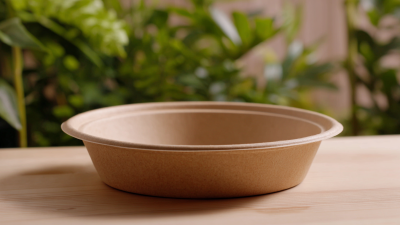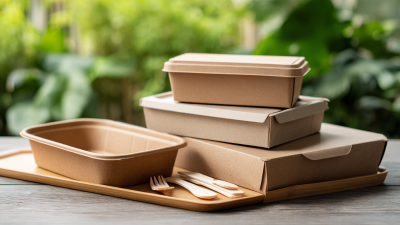In recent years, the environmental impact of traditional disposable tableware has come under intense scrutiny, prompting a significant shift towards Biodegradable Disposable Tableware. According to a 2021 report by Research and Markets, the global biodegradable tableware market is projected to reach $6.9 billion by 2026, driven by increasing consumer awareness and stringent regulations against plastic waste. This paradigm shift in dining options is fueled by growing environmental concerns, with experts estimating that the demand for sustainable products could reduce plastic pollution by up to 75% within the next decade. As restaurants and consumers alike prioritize eco-friendly choices, Biodegradable Disposable Tableware emerges not only as a viable alternative but also as a necessity for sustainable dining in the modern world.

In the realm of sustainable dining, biodegradable disposable tableware is emerging as a pivotal player. One of the foremost benefits is its significant reduction in landfill waste. According to a 2022 report from the Environmental Protection Agency (EPA), food service disposables made up over 20 million tons of waste in the United States alone. By opting for biodegradable options, businesses and consumers can drastically decrease their ecological footprint. These products can decompose in composting environments within 90 to 180 days, contrasting sharply with conventional plastic, which can take hundreds of years to break down.
Moreover, biodegradable tableware often boasts a lower carbon footprint during production. A study by the Institute of Biodegradable Materials highlighted that producing biodegradable materials emits 50% less carbon dioxide compared to traditional plastics. This shift not only aligns with the growing consumer demand for eco-friendly products but also supports a broader commitment to sustainability. As restaurants and catering services prioritize green practices, they stand to attract an increasingly environmentally conscious clientele, ultimately fostering a more sustainable dining culture. With the statistics emphasizing these benefits, the transition to biodegradable disposable tableware is not just wise—it's essential for the future of dining.
| Reason | Benefit | Environmental Impact | Biodegradation Time |
|---|---|---|---|
| 1. Made from Renewable Resources | Reduces reliance on fossil fuels | Decreases carbon footprint | 90-180 days |
| 2. Compostable Material | Contributes to nutrient-rich soil | Reduces landfill waste | 60-90 days |
| 3. Reduces Plastic Pollution | Minimizes ocean waste | Promotes healthier marine life | 90-180 days |
| 4. Safe for Food Use | Non-toxic and chemical-free | Protects human health | Varies by material |
| 5. Customizable Designs | Attractive and personalized options | Encourages mindful consumption | Varies by material |
| 6. Lightweight and Convenient | Easy to carry and use | Reduces transportation emissions | Varies by material |
| 7. Versatile Applications | Suitable for various events | Encourages sustainable practices | Varies by material |
| 8. Compliant with Regulations | Meets environmental standards | Supports legislation against single-use plastics | Varies by material |
| 9. Cost-Effective Options | Accessible price range for consumers | Promotes eco-friendly choices | Varies by material |
| 10. Supports Local Economies | Encourages use of local materials | Strengthens community sustainability | Varies by material |
As consumers become increasingly aware of environmental issues, the debate between biodegradable and traditional disposable tableware has gained momentum. Traditional disposable products, often made from plastic or Styrofoam, contribute significantly to landfill waste. According to the Ellen MacArthur Foundation, approximately 80% of plastic products end up in landfills after their single-use. In contrast, biodegradable tableware, often crafted from materials like cornstarch or sugarcane, can break down in composting facilities within 90 to 180 days, thus reducing long-term environmental impact.
A report by Grand View Research highlights the burgeoning demand for biodegradable tableware, which is expected to grow at a compound annual growth rate (CAGR) of over 10% from 2021 to 2028. This shift is not just a passing trend; it reflects a deeper commitment to sustainability in the food service industry. Businesses are increasingly opting for biodegradable options not only to meet regulatory changes but also to align with consumer preferences. Studies show that around 66% of global consumers are willing to pay more for sustainable products, indicating a clear market incentive for moving away from traditional disposable items.

The growing concern over plastic waste has made biodegradable disposable tableware a compelling alternative for sustainable dining. Unlike traditional plastic, which can take hundreds of years to decompose, biodegradable materials, often made from natural substances like cornstarch or sugarcane, break down much more quickly and safely in the environment. This significant reduction in the longevity of waste in landfills helps mitigate the ongoing crisis of plastic pollution, which threatens ecosystems and wildlife.
Adopting biodegradable tableware not only lessens the environmental impact but also encourages more responsible consumer behavior. Restaurants and catering services that offer these eco-friendly options invite their customers to participate in a collective effort to reduce waste. As consumers become increasingly aware of their ecological footprint, choosing biodegradable alternatives allows them to enjoy their meals without the guilt associated with single-use plastics. Embracing this shift not only reflects a commitment to a healthier planet but also exemplifies the sustainable dining experience that many diners are now seeking.
When selecting biodegradable disposable tableware for your dining needs, it’s essential to consider various factors that align with your sustainability goals. Recent research indicates that single-use plastics constitute approximately 50% of the global plastics waste, making the shift to biodegradable alternatives more crucial than ever. Products made from materials like plant starch, bamboo, and sugarcane not only break down more quickly in composting environments but also minimize the environmental impact associated with traditional plastics.
Choosing the right biodegradable tableware involves evaluating the material’s composting conditions. For instance, according to the Biodegradable Products Institute, items labeled as ASTM D6400 compliant can effectively decompose in commercial composting facilities, ensuring they contribute to a circular economy rather than polluting landfills. Additionally, opting for certified products can enhance your brand’s reputation, as a recent study from Deloitte found that 81% of consumers feel strongly that companies should help improve the environment. By making informed choices, you can elevate your dining experience while championing sustainability.

The future of sustainable dining is increasingly being shaped by innovative biodegradable materials. As consumers become more environmentally conscious, the demand for biodegradable disposable tableware is surging. The global bioplastic utensils market is projected to reach ¥17.06 billion by 2024, driven by a significant shift towards eco-friendly dining solutions. Among these, PLA (Polylactic Acid) and CPLA (Crystalline PLA) bioplastic utensils are leading the charge with their compostable properties, representing a sustainable alternative to traditional plastic cutlery.
Moreover, the inclusivity of various biodegradable materials is accelerating growth in this sector. The increase in regulatory measures, such as the recent implementation of plastic bans in various countries, is further propelling the need for sustainable alternatives in the food service industry. As businesses pivot to meet these new standards, they often turn to materials that not only fulfill sustainability criteria but also maintain functionality and user experience. Such innovations are essential to successfully transition from conventional plastic towards a greener, more responsible dining landscape.






